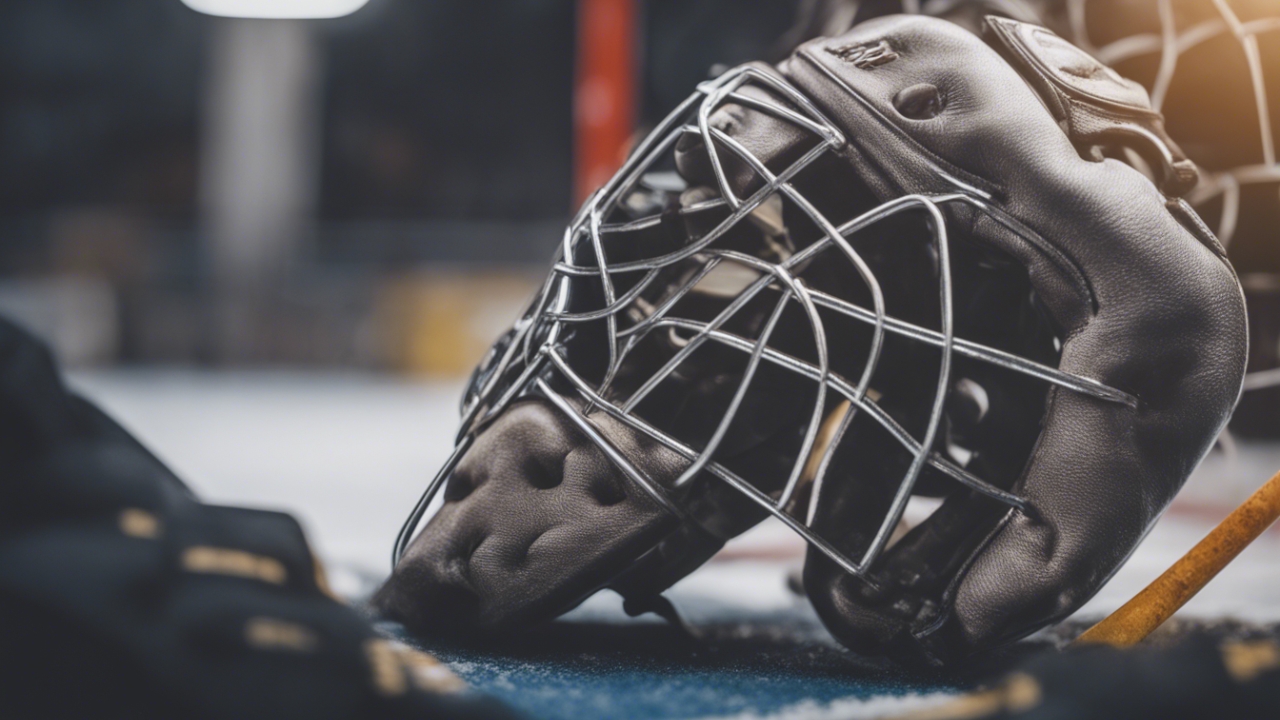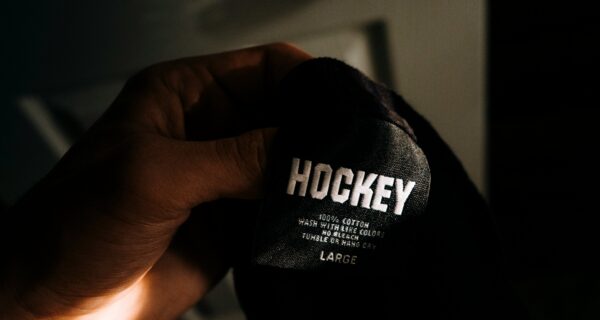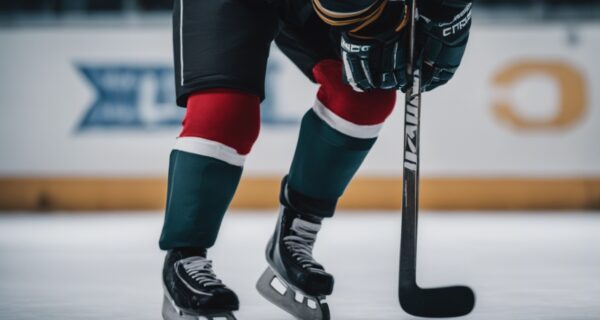To break in a hockey goalie glove, start by repeatedly closing the glove to soften its materials. Next, use a conditioning oil to treat the leather for increased pliability.
Breaking in a new hockey goalie glove is crucial for game-ready performance and comfort. A stiff glove can hinder your ability to catch and control the puck, so proper conditioning is important.
It begins with manual manipulation, where the goalie works the glove’s fingers and palm area, promoting flexibility through constant motion.
Treatment with specialized conditioners or oils specifically designed for leather sports equipment makes the material more supple.
This process not only ensures the glove molds to your hand for a custom fit but also extends its lifespan by maintaining the quality of the leather.
Patience is key; the break-in process can take several weeks of consistent effort.
Essentials of Hockey Goalie Gloves
The essentials of hockey goalie gloves are foundational for any goaltender stepping onto the ice.
A well-fitted and properly broken-in glove amplifies performance and confidence. Optimal dexterity, protection, and comfort differentiate between a good and great save.
Varieties and Designs
Selecting the right glove involves choices. Among these are catch angle, pocket depth, and wrist mobility. Let’s delve into these categories:
- Catch Angle: 600, 590, and 580 options suit different hand orientations.
- Pocket Depth: Shallow for quick puck access, deep for secure catch.
- Wrist Mobility: Flexible designs enable swift and wide-ranging movements.
Gloves are also tailored to levels from beginner to professional, scaling in features and durability.
Youths may prefer lighter, more pliable models, whereas pros need robust construction for stiffer shots.
Materials and Craftsmanship
Quality is king. High-grade materials yield a long-lasting glove. Commonly used elements include:
| Material | Benefits |
|---|---|
| Leather | Durability and classic feel |
| Synthetic Fibers | Lightweight and flexibility |
| Foam Padding | Impact absorption |
Craftsmanship includes precision stitching and strategic reinforcement. A glove’s lifespan depends on these details.
Advanced features like heat-moldable materials enhance fit, tailoring the glove’s contours to a goalie’s hand over time.
Preparation Before Breaking in
Setting the stage for a well-broken-in hockey goalie glove begins with preparation. It ensures the glove is flexible, comfortable, and optimized for performance.
A methodical approach will help you achieve a glove that feels like an extension of your hand. Start by gathering all necessary materials and understanding the process in detail.
Cleaning and Conditioning
Begin with a clean canvas—your goalie glove. Dirt and debris can hinder the breaking-in process, potentially damaging the materials.
Lightly brush off any loose dirt from the glove using a soft-bristled brush. For the conditioning phase, use a leather conditioner formulated for sports equipment.
This will ensure the leather remains supple and receptive to the shaping process. Apply the conditioner following the product’s instructions, paying special attention to areas that need more flexibility.
Tools You’ll Need
Having the right tools before you start can make the process smoother. Here is a checklist of items you’ll need:
- Leather conditioner: To nourish the glove’s material.
- Soft-bristled brush: For removing surface dirt.
- Clean clothes: Apply the conditioner and clean the gloves.
- Lacing tool: In case tightening or adjustments are required.
- Glove oil: Optional for some extra softening.
- Baseball or puck: To help shape the pocket.
Once equipped, you’re set to move into the actual breaking-in process, primed for success.
The Traditional Method
Breaking in a hockey goalie glove is crucial for top performance. The traditional method is time-tested and reliable. It makes the glove ready for games.
Playing Catch
One of the best ways to break in a goalie glove is by playing catch. This method mimics actual game conditions. It helps to soften the glove’s materials.
- Find a partner or use a rebounder.
- Throw a ball back and forth; emphasis on repetitive catching motions.
- Start with a softball and progress to harder throws.
- Do this regularly for consistent wear.
Using a Puck
To further break in the glove, use a puck. This technique strengthens the pocket area.
- Place the puck in the glove’s pocket.
- Wrap the glove with rubber bands to secure the puck.
- Leave it overnight to shape the pocket.
Repeat nightly to achieve the desired flexibility.
Advanced Techniques
Welcome to the ‘Advanced Techniques’ section, where savvy goalkeepers elevate their game by precisely breaking in their hockey goalie gloves.
Here, we delve into methods that combine tradition with innovation. Let’s ensure your glove is game-ready to make those pivotal saves.
Steam Treatment
Steam softens the leather, making it more pliable. Follow these steps for a successful steam treatment:
- Heat water in a pot or steam machine until it produces steam.
- Expose the glove to steam for a few minutes, carefully checking it so as not to over-soften.
- Once adequately steamed, work the glove’s fingers to loosen them.
- Let the glove dry naturally in an open position.
Glove Mallet Method
A glove mallet simulates the repeated impact of a puck. This method enhances glove flexibility through targeted strikes:
- Secure the glove on a solid surface.
- Strike the glove’s pocket with a glove or baseball mitt mallet.
- Focus on all areas – palm, breakpoints, and fingers.
- Repeat the process until the glove feels adequately flexible.
Technique | Tools Needed | Time Required |
Steam Treatment | Pot or steam machine | 5-10 minutes |
Glove Mallet | Glove mallet/baseball mitt mallet | 10-20 minutes |
Maintaining Flexibility and Form
Maintaining flexibility and form is key in breaking in a hockey goalie glove. A well-formed glove improves grip and ensures swift and responsive movements during a game.
With the right techniques, goalies can shape their gloves to fit their hands comfortably while preserving the integrity of the glove’s design.
Let’s explore how regular usage and storage practices can keep your goalie glove game-ready.
Regular Usage
Using your goalie glove often is the best way to maintain its flexibility. The more you catch and handle the puck during practice, the more your glove breaks in.
This regular usage helps the glove mold to the shape of your hand and keeps it from stiffening up. Consider the following tips:
- Play catch with a partner to work the glove’s material.
- Catch balls of various sizes to help stretch the pocket.
- Use the glove in all goalie drills to get a consistent feel.
Proper Storage Practices
Store your glove to prevent damage and maintain its form when not used. Keep these practices in mind:
- Keep the glove in a cool, dry place, away from direct sunlight.
- Do not compress the glove under other equipment.
- Consider using a glove conditioner made for sports equipment.
Troubleshooting Common Issues
Goalie gloves play a crucial role in hockey. A well-fitted, broken-in glove boosts confidence and performance. During the break-in period, issues might arise.
Knowing how to troubleshoot these can mean distinguishing between a good and great game.
Stiffness After Break-in
After the break-in period, you expected a soft and supple glove. But yours might still feel stiff and unwieldy. Don’t worry.
- Continue the break-in process by playing catch or using a glove mallet.
- Apply a small amount of glove conditioner to maintain flexibility.
- Store the glove with a ball tucked in the pocket to maintain shape.
Retaining Shape and Resilience
Breaking in a goalie glove isn’t just about achieving initial flexibility.
You must ensure it keeps its shape for optimum performance. Follow these tips:
- Rotate the glove during use, giving it rest periods to bounce back.
- Store your glove in a cool, dry place away from heat sources.
- Use a glove wrap when not in use to keep the shape intact.
Frequently Asked Questions
What is Hockey Goalie Glove Conditioning?
Hockey goalie glove conditioning involves techniques to soften and form the glove for improved performance and comfort.
Can You Soften a Goalie Glove Quickly?
Yes, applying glove conditioner and repeatedly opening and closing the glove can soften it more quickly.
Why Break in a Hockey Goalie Glove?
Breaking in the glove enhances flexibility, grip, and comfort, allowing for better game performance.
How Long Can You Break a Goalie Glove?
The break-in period varies, but it typically takes a few weeks of consistent use to feel fully comfortable.
Best Way to Shape a Goalie Glove?
The best way to shape a goalie glove is to repeatedly close and open it while applying glove oils or conditioners.
Can Heat Help Break in Goalie Gloves?
Moderate heat can make the leather more pliable, but too much heat can damage the glove, so use caution.
What Materials Soften Goalie Gloves?
Specialized glove conditioners, oils, and sometimes shaving creams soften goalie gloves effectively.
Diy Break in Hacks for Goalie Gloves?
Some DIY hacks include using a baseball glove mallet or wrapping the glove with a ball inside overnight.
Techniques to Avoid When Breaking in Gloves?
Avoid over-soaking, excessive heat, or harsh chemicals, as these can damage the glove’s material and integrity.
Should I Use Oils on My Goalie Glove?
While oils can help soften the glove, using the correct type specifically designed for goalie gloves is crucial to prevent damage.
Conclusion
Mastering the art of breaking in a hockey goalie glove is essential for optimal performance on the ice.
Following our step-by-step guide will ensure your glove is game-ready, offering comfort and protection.
Remember, patience and consistent care will shape your glove into the perfect extension of your hand.
Now, gear up and block those shots with confidence!












